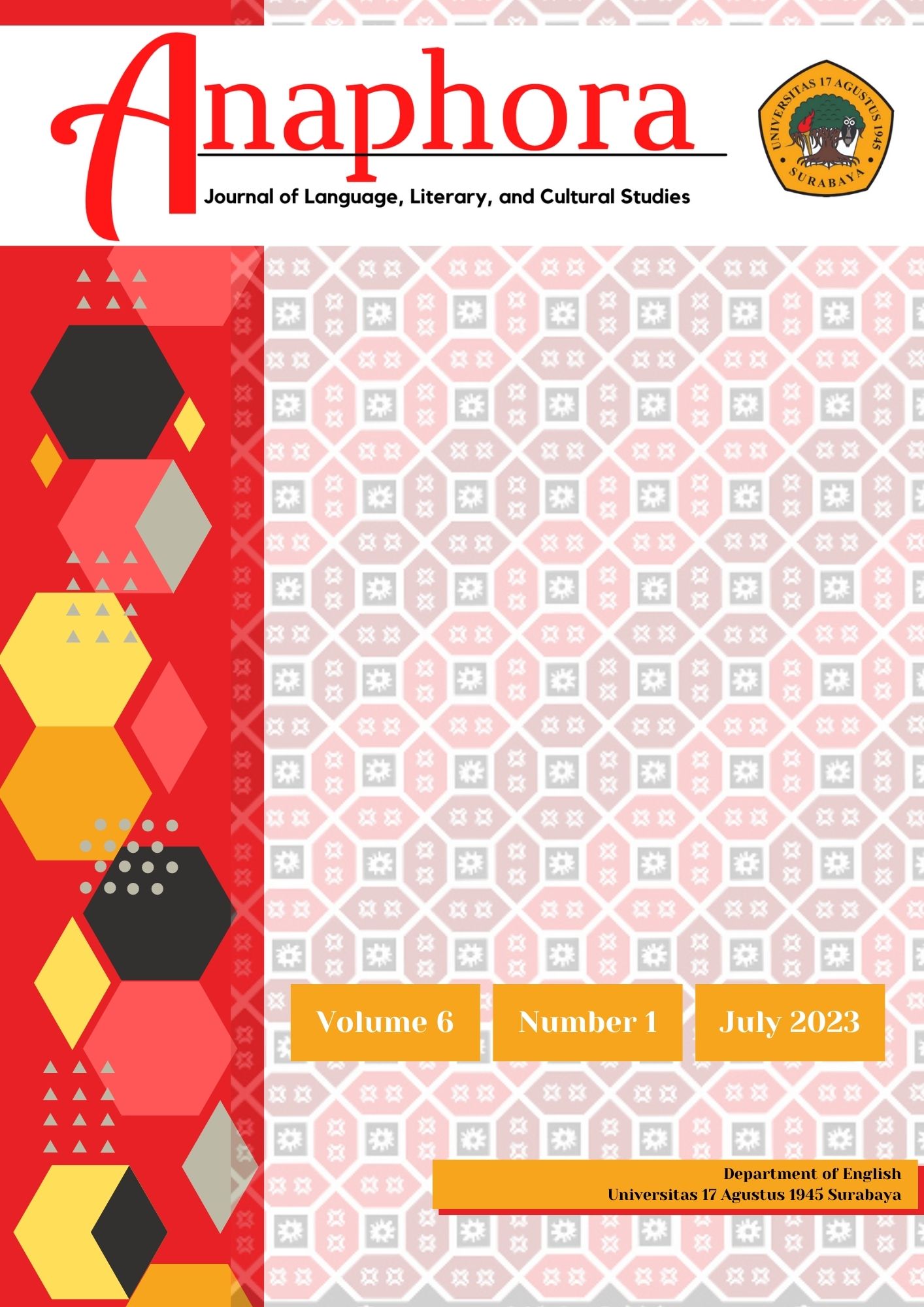How to Perform English Word Stress on English Pronunciation
Abstract
Word stress is a suprasegmental feature in English pronunciation. The word stress supports the correct articulation of English pronunciation. This qualitative research revealed the position of stress in English words. This research captured the pattern of English word stress. There are several phonologists discussing the word stress such as Chomsky, Hale, and Giegerich. The data taken was from the Oxford English Dictionary and from the English native spoken by observing, reading, listening, and noting. The way to analyze the data applied the textual analysis. The result of this research is the pattern of the English word stress articulation. From this research, it is known that the number of syllables determines the position of the stress. The ultimate stress occurs in two-syllable words. The penultimate and antepenultimate syllables occur in the words which have more than two syllables. The stress in the first syllable occurs in one-syllable, two-syllable, three-syllable, and four-syllable words. Stress does not fall on the affixes. However, the stress falls on the preposition for phrasal verbs. There is variation of stress position on the compound nouns and noun phrases due to their formation. Knowing stress’ position while pronouncing English helps distinguish the meaning literally.
Downloads
References
Abker, I. A. A. (2019). Pronunciation problems of words’ stress placement in English by Saudi students at Albaha University, Saudi Arabia. a case study at Almandag. International Journal of Applied Linguistics & English Literature, 8(6), 103–113. https://doi.org/http://dx.doi.org/10.7575/aiac.ijalel.v.8n.6p.103
Ambalegin, A. (2021a). Phonological analysis of English consonants pronunciation. Journal of Applied Studies in Language, 5(1). https://doi.org/http://dx.doi.org/10.31940/jasl.v5i1.2341
Ambalegin, A. (2021b). Phonological analysis of English vowel pronunciation. Annual International Conference on Language and Literature, 28–45. https://doi.org/https://doi.org/10.18502/kss.v5i4.8665
Carr, P. (2013). English phonetics and phonology: An introduction (2nd ed.). Blackwell Publishiing.
Chomsky, N., & Halle, M. (1991). The sound pattern of English. The MIT Press.
Creswell, J. W., & Poth, C. N. (2018). Qualitative inquiry & research design (4th ed.). Sage Publication Inc.
Crystal, D. (2003). English as a global language (Second Edi). Cambridge University Press.
Dash, B. B. (2013). An analysis of ‘stress’ in English language: A study of the rules and approaches. Electronic International Interdisciplinary Research Journal, 2(1), 121–130. https://doi.org/10.5281/EIIRJ.7121003
Frey, L. R., Botan, C. H., & Kreps, G. L. (2000). Investigating communication: An introduction to research methods (2nd ed.). Allyn and Bacon.
Ghosh, M., & Levis, J. M. (2021). Vowel quality and direction of stress shift in a predictive model explaining the varying impact of misplaced word stress: evidence from English. Frontiers in Communication, 6(April), 1–18. https://doi.org/https://doi.org/10.3389/fcomm.2021.628780
Giegerich, H. J. (2003). English phonology An introduction. Cambridge University Press.
Hancock, M. (2003). English pronunciation in use: Self-study and classroom use. Cambridge University Press.
Heuven, V. J. van. (2019). Acoustic correlates and perceptual cues of word and sentence stress: Towards a cross-linguistic perspective. In R. Goedemans, J. Heinz, & H. van der Hulst (Eds.), The study of word stress and accent: Theories, methods and data (pp. 15–59). Cambridge University Press. https://doi.org/DOI: 10.1017/9781316683101
Jones, D. (2006). Cambridge English pronunciation dictionary (P. Roach, J. Hartman, & J. Setter (eds.); 17th ed.). Cambridge University Press.
Kreidler, C. W. (2004). The pronunciation of English (second edi). Blackwell Publishiing.
Krisdianata, Y. Y., & Bram, B. (2022). Word stress errors made by English education master’s program students. Academic Journal PERSPECTIVE: Language, Education and Literature, 10(1), 1–12. https://doi.org/DOI: http://dx.doi.org/10.33603/perspective.v10i1.6763
Ladefoged, P. (2006). A course of phonetics (5th ed.). Thomson Wadsworth.
Ladefoged, P., & Disner, S. F. (2012). Vowels and consonants (third). Blackwell Publishing.
Lasut, P. A. (2015). Word stress contribution in second language acquisition. Https://Doi.Org/10.24071/Joll.V15i2.200, 15(2), 163–167. https://doi.org/https://doi.org/10.24071/joll.v15i2.200
Lee, G., Shin, D.-J., & Garcia, M. T. M. (2019). Perception of lexical stress and sentence focus by Korean-speaking and Spanish-speaking L2 learners of English. Language Sciences, 72(March), 36–49. https://doi.org/https://doi.org/10.1016/j.langsci.2019.01.002
Litosseliti, L. (2018). Research methods in Linguistics (2nd edition). Continuum International Publishing.
Liu, D. (2017). The acquisition of English word stress by Mandarin EFL learners. English Language Teaching Canadian Center of Science and Education, 10(12), 196–201. https://doi.org/DOI:10.5539/elt.v10n12p196
Merriam, S. B., & Tisdell, E. B. (2016). Qualitative research: A guide to design an implementation (4th ed.). A Willey Brand.
Nawaz, S., Ramzan, M., Khan, M. A., Rehman, W., & Tanoli, Z. A. (2020). A study on Urdu speakers’ use of English stress patterns: Phonological variation from native speakers. Ilkogretim Online - Elementary Education Online, 19(4), 6215–6235. https://doi.org/doi: 10.17051/ilkonline.2020.04.765028
Puspandari, L. E., & Basthomi, Y. (2022). The influence of Madurese dialect on students’ English word stress. INDONESIAN JOURNAL OF APPLIED LINGUISTICS, 12(1), 147–155. https://doi.org/DOI: https://doi.org/10.17509/ijal.v12i1.46896
Roach, P. (2012). English phonetics and phonology; A practical course (4th ed.). Cambridge University Press.
Sahoo, S. (2020). A morphological insight into English word stress system. International Journal of Innovations in TESOL and Applied Linguistics, 5(3). http://www.ijital.org/archive-18.html
Sudaryanto, S. (2015). Metode dan aneka teknik analisis bahasa. Duta Wacana University Press.
Syarifah, S., Warsono, W., & Fitriati, S. W. (2020). English word stress production of male and female Madurese students. English Education Journal, 10(1), 102–109. DOI 10.15294/EEJ.V10I1.34059
Taylor, S. J., Bogdan, R., & DeVault, M. L. (2016). Introduction to Qualitative Research Methods (4th ed.). John Wiley & Sons, Inc.
Ulfah, M., Rejeki, S., & Suharyati, H. (2022). An analysis of word stress in the news reading videos of public relations students. Journal Albion: Journal of English Literature, Language, and Culture, 4(1), 23–27. https://doi.org/DOI: 10.33751/albion.v4i1.5246
Weda, S. (2018). Problems on English word stress placement made by Indonesian learners of English. ELS Journal on Interdisciplinary Studies on Humanities, 1(3), 328–341. https://doi.org/https://doi.org/10.34050/els-jish.v1i3.4561
Widagsa, R., Wiyanah, S., & Wahyuni, P. (2019). The influence of Indonesian prosodic features on English word stress production. ENGLISH REVIEW: Journal of English Education, 7(2), 77–84. https://doi.org/10.25134/erjee.v7i2.1647
Yana, W. K. (2017). An analysis of L2 stress patterns of polysyllabic academic vocabulary of Indonesian students. English Education: Jurnal Tadris Bahasa Inggris, 10(2), 358–375. https://doi.org/https://doi.org/10.24042/ee-jtbi.v10i2.1756
Yule, G. (2017). The study of language (sixth). Cambridge University Press.
Zanten, E. van, & Goedemans, R. (2009). Prominence in Indonesian: Stress, phrases, and boundaries. Wacana, 11(2), 197–229. https://doi.org/http://dx.doi.org/10.17510/wjhi.v11i2.158
Zanten, E. van, & Heuven, V. J. van. (1998). Word stress in Indonesian; Its communicative relevance. Bijdragen Tot de Taal-, Land- En Volkenkunde / Journal of the Humanities and Social Sciences of Southeast Asia, 154(1), 129–149. https://brill.com/view/journals/bki/154/1/article-p129_7.xml
Copyright (c) 2023 Ambalegin Ambalegin, Afriana Afriana

This work is licensed under a Creative Commons Attribution-ShareAlike 4.0 International License.
Authors whose manuscript is published will approve the following provisions:
-
The right to publication of all journal material published on the jurnal anaphora website is held by the editorial board with the author's knowledge (moral rights remain the property of the author).
-
The formal legal provisions for access to digital articles of this electronic journal are subject to the terms of the Creative Commons Attribution-ShareAlike (CC BY-SA) license, which means Jurnal Persona reserves the right to store, modify the format, administer in database, maintain and publish articles without requesting permission from the Author as long as it keeps the Author's name as the owner of Copyright.
-
Printed and electronic published manuscripts are open access for educational, research and library purposes. In addition to these objectives, the editorial board shall not be liable for violations of copyright law.




